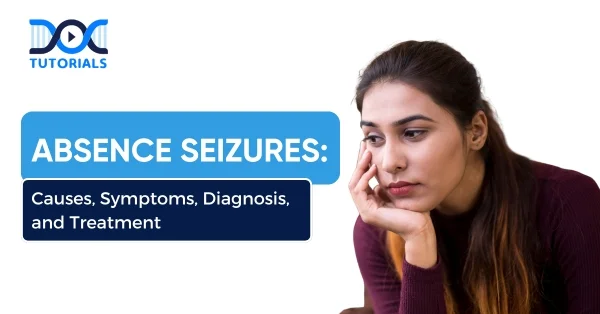Absence Seizures: Causes, Symptoms, Diagnosis, and Treatment

Absence seizure represents a distinct form of generalised epilepsy, marked by brief and sudden lapses in consciousness. Physical injury during such seizures is uncommon, making them easily overlooked or mistaken for simple inattentiveness. This condition is more prevalent in children, though adults may also be affected.
For NEET aspirants, understanding absence seizure is essential for developing a thorough grasp of neurological disorders. A strong foundation in the causes, clinical features, diagnostic methods, and treatment strategies is vital for both academic preparation and future clinical application.
What are Absence Seizures?
Absence seizures, previously known as petit mal seizures, are short periods associated with a loss of consciousness and staring. These seizures often begin without warning and usually last between three and fifteen seconds. While frequently seen in children, they can also affect adults.
These episodes may occur during everyday activities such as speaking or listening, where the individual abruptly pauses. A few seconds later, they usually continue as if nothing had occurred.
To an observer unfamiliar with the condition, the behaviour may resemble daydreaming or inattentiveness, when in reality, a seizure is taking place. Absence seizures fall under the category of generalised seizures and are classified as either typical or atypical.
What are the Different Types of Absence Seizures?
There are two types of absent seizures:
- Simple Absence Seizures
These are brief in nature and last only a few seconds. They tend to show no or little symptoms, which are mostly a vacant stare and a lack of responsiveness towards the environment.
- Complex Absence Seizures
This type of seizure tends to last a bit longer, sometimes up to 20 seconds, and may be accompanied by subtle physical actions such as rapid blinking, lip-smacking, or slight movements of the hands.
What are the Causes of Absence Seizures?
The root cause of absence seizures is still ambiguous, but several contributing factors lead to this condition:
- Genetic Influence
The risk of developing the condition is higher in people who have a familial history of epilepsy or absence seizures.
- Brain Structure Irregularities
Abnormalities in brain structure have been linked to the onset of absence seizures.
- Electrolyte Disturbances
Disruptions in the balance of essential electrolytes, such as calcium or sodium, may provoke seizure activity.
What are the Risk Factors of Absence Seizures?
Several characteristics are frequently observed in children who experience absence seizures:
- Age Group: These seizures tend to occur more often in children aged between 4 and 14 years.
- Gender: The prevalence rate of absence seizures in females is high when compared to males.
- Family History: Around 25% of affected children have a first relative who also has seizures.
What are the Symptoms of Absence Seizures?
Identifying absence seizure symptoms plays a key role in ensuring prompt diagnosis and effective management. The most frequently observed signs include:
- Vacant Staring
Individuals may abruptly halt their activity and fix their gaze into space.
- Unresponsiveness
During an episode, there is no reaction to external cues such as someone speaking or calling out.
- Minor Physical Movements
There can be other accompanying activities such as quick blinking, smacking of lips, or small movements of the hand during the seizure.
- Interrupted Actions
An individual may get stuck in the middle of a sentence or lose track of the point in a conversation.
How to Diagnose Absence Seizures?
Several tests are commonly used to confirm a diagnosis of absence seizures:
- Hyperventilation Test
Controlled hyperventilation may provoke an absence seizure. A medical practitioner may ask the child to blow a piece of paper or a pinwheel continuously over a period of two minutes to see a possible seizure.
- Blood and Urine Tests
These tests are useful in establishing some underlying medical disorder or metabolic imbalance, which could have triggered seizures.
- MRI or CT Scan
Structural abnormalities of the brain that potentially trigger seizure activity are observed via magnetic resonance imaging or computed tomography.
- Electroencephalogram (EEG)
This test records the brain’s electrical signals using sensors placed on the scalp. Absence seizures are identified by a distinctive pattern in the brain’s wave activity.
What are the Treatment Options for Absence Seizures?
Absence seizures are usually treated through the use of anti-seizure drugs, although other methods are used when drugs are inadequate. Here is a detailed overview:
- Ethosuximide (Zarontin)
Ethosuximide is usually the first-line medication to treat absence seizures. It has been proven to decrease the seizures in a large number of people. Some of the usual side effects are nausea, which can be accompanied by vomiting, somnolence, insomnia, and hyperactivity.
- Valproic Acid
This medication is often prescribed for individuals experiencing both absence seizures and tonic-clonic (grand mal) seizures. Increased appetite, weight gain, nausea, and attention issues are some of the side effects of the drug. In exceptional cases, it can cause pancreatic inflammation or liver failure.
Due to its association with a higher risk of birth defects, it is usually avoided during pregnancy or when planning to conceive.
- Lamotrigine (Lamictal)
Although this medication is not as effective as ethosuximide or valproic acid, it has fewer side effects in most cases. Side effects, including nausea and skin rash, have been reported.
In cases where medication is not fully effective, complementary strategies may support absence seizures treatment. They may include:
- Ketogenic Diet
A high-fat, low-carbohydrate diet may reduce seizures by altering how the brain utilises energy. An individual should follow this dietary approach only under medical guidance. Less restrictive variants, such as the modified Atkins diet and low-glycaemic-index diet, may also provide benefits.
- Vagus Nerve Stimulation (VNS)
This technique involves sending mild electrical signals to the vagus nerve, which influences essential bodily functions such as heart rate. VNS may be considered for individuals whose absence seizures do not respond to medication.
FAQs About Absence Seizures
- What is the frequency of occurrence of absence seizures in affected individuals?
Absence seizures can occur quite frequently, depending on the severity of the condition and on individual factors. Moreover, in certain instances, individuals may experience brief absence seizures as many as 50 times per day. Nevertheless, in most children, the frequency of episodes can be significantly reduced with the use of appropriate anti-seizure medication.
- What are the possible complications of absence seizures?
Although many children eventually outgrow absence seizures, some may face long-term challenges. A number of individuals may require lifelong use of anti-seizure medication. In certain cases, generalised tonic-clonic seizures can develop over time. Additional complications may include learning difficulties, behavioural issues, social withdrawal, and, in rare instances, injury occurring during a seizure episode.
- Do children with absence seizures always need lifelong treatment?
Children with absence seizures do not always need lifelong treatment. Some grow out of the condition in adolescence, and one day they might no longer need medication as well. Nevertheless, not all of them stop having seizures in adulthood, and some require constant control.
- What are the treatment options for managing absence seizures in adults?
Adults diagnosed with absence seizures are typically treated using anti-seizure medications aimed at reducing or preventing seizure episodes. Commonly prescribed drugs include lamotrigine (Lamictal), ethosuximide (Zarontin), valproic acid (Depakene), and divalproex sodium (Depakote). These medications help control the abnormal electrical activity in the brain that leads to seizures.
- Are absence seizures hereditary?
A family history of epilepsy or absence seizures can increase the risk of developing the condition.
Conclusion
Given the subtle presentation of absence seizures, especially in children, timely diagnosis is key to preventing potential cognitive and behavioural complications. Proper medical management, supported by dietary or device-based interventions when required, can significantly improve patient outcomes.
This topic holds particular importance for NEET PG aspirants, as it strengthens clinical reasoning and equips future healthcare professionals to recognise and manage neurological disorders effectively. With DocTutorials, aspirants gain access to a thorough NEET PG preparation platform featuring expert-led discussions, high-yield video lectures, and comprehensive study resources.Check out our NEET PG study materials today!
Latest Blogs
-

NEET PG Exam 2025- Date, Pattern, Marking Scheme, Subject Wise Weightage, and Exam Mode
NEET PG Exam 2025 is the ultimate gateway for medical graduates aspiring to pursue postgraduate courses in medicine, including MD,…
-

INI CET Exam 2025: Your Roadmap to Success – Key Topics, Strategies, and Lessons from Last Year’s Papers
The INI CET exam is more than just a test; it’s a significant milestone for many medical students aiming to…
-

INI CET Exam Success: Previous Year Question Papers & Ultimate Guide – INI CET PYQ
One can feel overwhelmed while preparing for the INI CET (Institute of National Importance Combined Entrance Test). A vast syllabus,…




